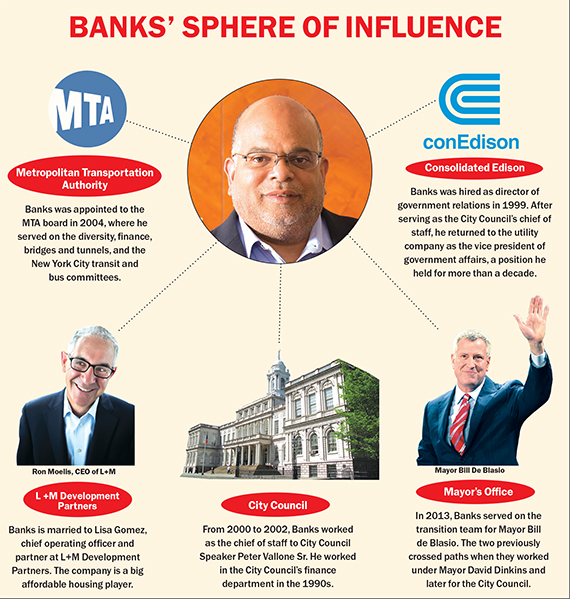Last month, with the future of 421a still unresolved, two titans of the real estate industry clashed over how to reinstate the tax subsidy. The two men, Real Estate Board of New York Chairman Rob Speyer, who heads Tishman Speyer, and Stephen Ross, the chairman of Related Cos., argued intensely, and depending on who you ask, nearly came to blows before reconciling by shaking hands (and by some accounts, hugging) outside REBNY’s Midtown headquarters.
Nonetheless, the incident was a brief window into the inner politics of REBNY, the most powerful group representing the interests of developers in the city, and served to highlight one of the bigger challenges facing John Banks III, 54, who is entering his second year as REBNY’s president.
“The hardest of all has been the 421a experience,” said Mary Ann Tighe, CEO of the tri-state region for CBRE and former chairwoman of REBNY, who added that news accounts of the Speyer-Ross argument were exaggerated. “While there’s consensus among the real estate industry as a whole that 421a was a vital program, there was considerable splintering as to how to keep it.”
For his part, Banks, who is measured with his comments, likened the role of managing discord in REBNY to that of a level-headed parent who brings reason to the table.
“When your kids want ice cream for breakfast, you try to talk to them and reach a consensus,” Banks told The Real Deal. “And the consensus is, you can’t have ice cream. My job, as I view it, is to give those dissenting opinions an opportunity to be heard, and then we try to move to a consensus position.”
Fresh face
The job of REBNY president is political on multiple levels: It requires near constant communication with City Hall and Albany— keeping tabs on issues that directly impact real estate — all the while serving as a unified voice for the industry, even when there’s discord among the organization’s ranks. A year into the job, Tighe said that one of Banks’ strengths is that he brings a “very even keel” to the table, something that is necessary when dealing with the people who form REBNY’s board of governors, who are essentially the “kings and queens in their domain.”
The task has been even more formidable considering that Banks is a relative newcomer to the high-stakes world of NYC real estate. Although his wife, Lisa Gomez, is chief operating officer at L+M Development Partners, a big player in affordable housing, he said he has spent a large chunk of his time meeting with industry leaders in an attempt to establish deeper connections with the industry.
He is a fresh face in more than one respect. When his hiring was announced last year, the organization made a point of noting that he was REBNY’s first African-American leader. Founded in 1896, REBNY has been made up of mostly white males.
 Bertha Lewis, president of the Black Institute and an advocate who crossed paths with Banks when he worked on the City Council and she was at the Association for Community Organization for Change Now (Acorn), said she was pleasantly surprised when she found out Banks was REBNY’s new president.
Bertha Lewis, president of the Black Institute and an advocate who crossed paths with Banks when he worked on the City Council and she was at the Association for Community Organization for Change Now (Acorn), said she was pleasantly surprised when she found out Banks was REBNY’s new president.
“REBNY is not what you would call a bastion for liberal, progressive tendencies,” she said. “REBNY is a big, big deal. To have an African-American as president? Are you kidding me? That’s like a supernova.”
Banks himself has made little of his trailblazing appointment, saying only that the “industry clearly recognizes the importance of diversity.”
Ultimately, it was his deep understanding of how the city functions that was likely critical in getting him hired. A former government official, Banks has worked for the City Council, the Metropolitan Transportation Authority and Consolidated Edison and operated behind the scenes as a lobbyist. Along the way, he has connected with key city officials and politicians, including Bill de Blasio, who appointed him as part of his mayoral transition team in 2013.
“He’s one of the most diplomatic men I’ve ever met,” said Joseph Lhota, who served as deputy mayor under Mayor Rudy Giuliani and has known Banks for more than 20 years. Lhota ran against de Blasio in 2013.
He added: “I think John’s got the firepower to do what’s necessary, both here in the city and up in Albany.”
The push to bring back 421a
REBNY having sway with politicians has never proved more important than with the 421a negotiations. All told, a lobbying group tied to REBNY spent $2 million in 2015 in an effort to influence state and local governments, according to a report by the Joint Commission on Public Ethics.
But on 421a at least, the results have been disappointing. The property tax abatement lapsed in January after labor groups and REBNY were unable to strike an agreement over whether workers should be paid union wages. Though REBNY has certainly helped shape government policies in the past, the fact that the trade group and local unions were publicly tasked with coming to an agreement was unusual. Those close to the talks say having a key policy issue rest so heavily on the two groups’ shoulders is not likely to be replicated at any time in the near future.
Last month, Gov. Andrew Cuomo said he believed that a replacement program would be instated before the end of the legislative session in June. However, in a later speech, the governor said he wouldn’t sign any bill that wasn’t favorable to unions. REBNY has repeatedly argued that requiring prevailing wages on 421a projects would increase costs and result in less affordable housing.
While the issue appears to be at a stalemate, Banks said the organization hasn’t stopped working on it, and REBNY members have not complained, at least not openly, about the way he has managed the negotiations.
“We have to figure out another solution to creating affordable rental housing. So we work every day to see if there is some other alternative to 421a,” he said. “Just because the legislation has lapsed doesn’t mean that we’re not thinking about it [and] engaging in a dialogue with various stakeholders on what would work to create affordable rental housing.”
A packed agenda
The 421a program aside, there has been no shortage of issues involving the real estate community. When a crane collapsed in Tribeca in February and killed a 38-year-old man, de Blasio changed the wind-speed threshold for operating the equipment, requiring that cranes be shut down when wind speeds exceed 20 mph. The new limit was opposed by the construction industry, which argued that work sites would experience a slowdown.
Behind the scenes, Banks worked with Department of Building officials on its “knee-jerk” reaction, Tighe said.

A month later, the administration walked back from these reforms, returning instead to the original rules, which mandated that crane work stop when wind speeds go above 30 mph.
It’s not the only city policy REBNY is trying to shape. The organization recently intensified its fight against Local Law 50, which passed last year and prevents hotels with more than 150 rooms from converting more than 20 percent of their space to residential or non-hotel use. The city argued that too many hotels were being transformed into luxury condos, costing scores of hotel workers their jobs. REBNY, however, maintained that the measure wrongfully bypassed the city’s land-use process. Not to mention it prevented some developers from cashing in on potentially lucrative conversions at a time when the hotel market is showing signs of slowing down. Banks took up the cause shortly after taking office, turning to litigation after exhausting negotiations with the city.
Banks has also turned his attention to longer-term concerns for the industry. He is trying to curb the carbon footprint of the city’s buildings by launching a “Sustainability Boot Camp” to help building managers and others meet de Blasio’s goal of reducing greenhouse gas emissions 80 percent by 2050.
And as part of the organization’s expansion to the outer boroughs, Banks in February welcomed Brooklyn-based brokerage Fillmore Real Estate.
In an uncharacteristic off-the-cuff pep talk, the president assured the brokerage that REBNY had its back.
“If you need something, pick up the phone and we will get it for you,” he told the group. “We will work our asses off to make sure that you are successful. You’re part of our family, you’re part of our community.”
Going forward, REBNY will also likely continue to zero in on the city’s affordable housing crisis, though Banks doesn’t anticipate completely solving that issue in his tenure, however long that may be. Although he did not have a specific number of years in mind, he said he will not stay as long as his predecessor Steve Spinola, whose three-decade tenure made him the longest-serving president of REBNY.
“I don’t have an end date in sight, but I know it’s not 30 years,” he said.
As evidenced with the crane crash, the job can be unpredictable, often because REBNY’s concerns intersect with unexpected issues that come up in the city. Banks pointed to the widespread breakout of Legionnaires’ disease last year and how he never would have expected REBNY to play a role in the crisis, saying the organization actively helped landlords address the problem.
“On any given day you can have four or five major issues you are dealing with,” he said.
He added: “The real estate industry is so ubiquitous in the life of New York that it touches every aspect of the great experiment that is New York.”
Rich Bockmann contributed reporting to this story.
